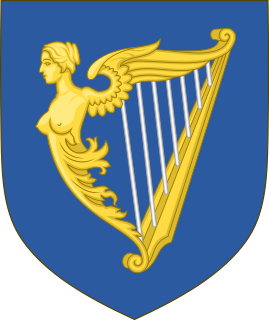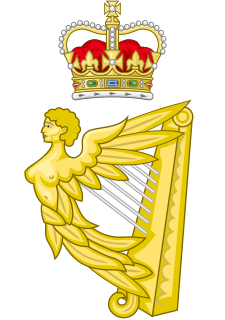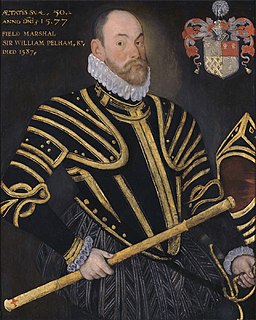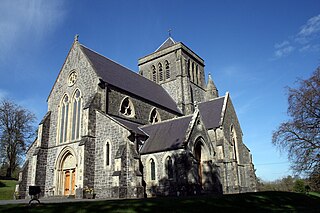Related Research Articles

The Irish House of Commons was the lower house of the Parliament of Ireland that existed from 1297 until 1800. The upper house was the House of Lords. The membership of the House of Commons was directly elected, but on a highly restrictive franchise, similar to the unreformed House of Commons in contemporary England and Great Britain. Catholics were disqualified from sitting in the Irish parliament from 1691, even though they comprised the vast majority of the Irish population.

Monarchical systems of government have existed in Ireland from ancient times. In the south this continued until the early twentieth century, when it transitioned to the Republic of Ireland. Northern Ireland, as part of the United Kingdom, remains under a monarchical system of government.

The Parliament of Ireland was the legislature of the Lordship of Ireland, and later the Kingdom of Ireland, from 1297 until 1800. It was modelled on the Parliament of England and from 1537 comprised two chambers: the House of Commons and the House of Lords. The Lords were members of the Irish peerage and bishops. The Commons was directly elected, albeit on a very restricted franchise. Parliaments met at various places in Leinster and Munster, but latterly always in Dublin: in Christchurch Cathedral, Dublin Castle, Chichester House (1661–1727), the Blue Coat School (1729–31), and finally a purpose-built Parliament House on College Green.
His or Her Majesty's Privy Council in Ireland, commonly called the Privy Council of Ireland, Irish Privy Council, or in earlier centuries the Irish Council, was the institution within the Dublin Castle administration which exercised formal executive power in conjunction with the chief governor of Ireland, who was viceroy of the British monarch. The council evolved in the Lordship of Ireland on the model of the Privy Council of England; as the English council advised the king in person, so the Irish council advised the viceroy, who in medieval times was a powerful Lord Deputy. In the early modern period the council gained more influence at the expense of the viceroy, but in the 18th century lost influence to the Parliament of Ireland. In the post-1800 United Kingdom of Great Britain and Ireland, the Irish Privy Council and viceroy Lord Lieutenant had formal and ceremonial power, while policy formulation rested with a Chief Secretary directly answerable to the British cabinet. The council comprised senior public servants, judges, and parliamentarians, and eminent men appointed for knowledge of public affairs or as a civic honour.
Wexford County was a UK Parliament constituency in Ireland, which returned two Members of Parliament (MPs) to the United Kingdom House of Commons.

The Lords Justices were deputies who acted collectively in the absence of the chief governor of Ireland as head of the executive branch of the Dublin Castle administration. Lords Justices were sworn in at a meeting of the Privy Council of Ireland.
Cork City was a constituency represented in the Irish House of Commons to 1800.
Baltimore was a potwalloper constituency represented in the Irish House of Commons from 1614 to 1801.
Castlemartyr was a constituency represented in the Irish House of Commons from 1676 to 1800.
Ardfert was a constituency represented in the House of Commons of the Parliament of Ireland until the Act of Union 1800.

The Bishop of Kilmore is an episcopal title which takes its name after the parish of Kilmore, County Cavan in Ireland. In the Roman Catholic Church it remains a separate title, but in the Church of Ireland it has been united with other bishoprics.
The Bishop of Meath is an episcopal title which takes its name after the ancient Kingdom of Meath. In the Roman Catholic Church it remains as a separate title, but in the Church of Ireland it has been united with another bishopric.
Events from the year 1350 in Ireland.
Events from the year 1351 in Ireland.
Events from the year 1337 in Ireland.
Armagh County was a constituency represented in the Irish House of Commons, the house of representatives of the Kingdom of Ireland, until 1800.

The Restoration of the monarchy began in 1660. The Commonwealth of England, Scotland and Ireland (1649–60) resulted from the Wars of the Three Kingdoms but collapsed in 1659. Politicians such as General Monck tried to ensure a peaceful transition of government from the "Commonwealth" republic back to monarchy. From 1 May 1660 the English, Scottish and Irish monarchies were all restored under King Charles II. The term Restoration may apply both to the actual event by which the monarchy was restored, and to the period immediately before and after the event.

Upper Ossory was an administrative barony in the south and west of Queen's County in Ireland. In late Gaelic Ireland it was the túath of the Mac Giolla Phádraig (Fitzpatrick) family and surviving remnant of the once larger kingdom of Ossory. The northernmost part of the Diocese of Ossory and medieval County Kilkenny, it was transferred to the newly created Queen's County in 1600. In the 1840s its three component cantreds, Clarmallagh, Clandonagh, and Upperwoods, were promoted to barony status, thereby superseding Upper Ossory.
The Great Seal of Ireland was the seal used until 1922 by the Dublin Castle administration to authenticate important state documents in Ireland, in the same manner as the Great Seal of the Realm in England. The Great Seal of Ireland was used from at least the 1220s in the Lordship of Ireland and the ensuing Kingdom of Ireland, and remained in use when the island became part of the United Kingdom of Great Britain and Ireland (1801–1922), just as the Great Seal of Scotland remained in use after the Act of Union 1707. After 1922, the single Great Seal of Ireland was superseded by the separate Great Seal of the Irish Free State and Great Seal of Northern Ireland for the respective jurisdictions created by the partition of Ireland.
References
- A New History of Ireland, Volume IX, edited by T. W. Moody, F.X. Martin and F.J. Byrne (Clarendon Press 1984), ISBN 0-19-821745-5
- ↑ Lydon, James F. (Summer 1995). "'Ireland Corporate of itself' the Parliament of 1460". History Ireland. 3 (2). JSTOR 27724246.
- ↑ Curtis, Edmund; McDowell, Robert Brendan (1968). Irish historical documents, 1172-1922. Barnes & Noble. p. 73.
- ↑ Ireland (1765). "Chap. XXIII An Act repealing a Parliament holden at Drogheda, before Robert Prestone, lord of Gormanstowne. Rot. Parl. cap. 40". The Statutes at Large: From the third year of Edward the Second, A.D. 1310, to the eleventh, twelfth and thirteenth years of James the First, A.D. 1612, inclusive. Vol.1. B. Grierson. p. 57.
|volume=has extra text (help) - ↑ 1Statute 8 Edw. 4 sess. 3 c. 6; Edwards, R. Dudley; Moody, T. W.; Otway-Ruthven, Jocelyn; Quinn, David B.; Richardson, H. G. (1942). "Parliaments and Great Councils in Ireland, 1461-1586". Irish Historical Studies. 3 (9): 60–77: 67. ISSN 0021-1214. JSTOR 30005995.
- ↑ Ellis, S. G. (1980). "Parliaments and Great Councils, 1483-99: Addenda et Corrigenda". Analecta Hibernica. Irish Manuscripts Commission (29): 96, 98–111 : 101–102. JSTOR 25511959.
- ↑ Clarke, Aidan (1976). A New History of Ireland, Volume III, Early Modern Ireland, 1534-1691, edited by T. W. Moody, F.X. Martin and F.J. Byrne. Oxford : Clarendon Press. p. 213.
- ↑ Dissolved by the King's death
- ↑ Statutes Passed in the Parliaments Held in Ireland: 1665-1712. George Grierson, printer to the King's Most Excellent Majesty. 1794. pp. 241–3.
- ↑ Davis, Thomas Osborne. "The Irish Parliament of James II". CELT. University College Cork. p. 54. Retrieved 18 May 2017.